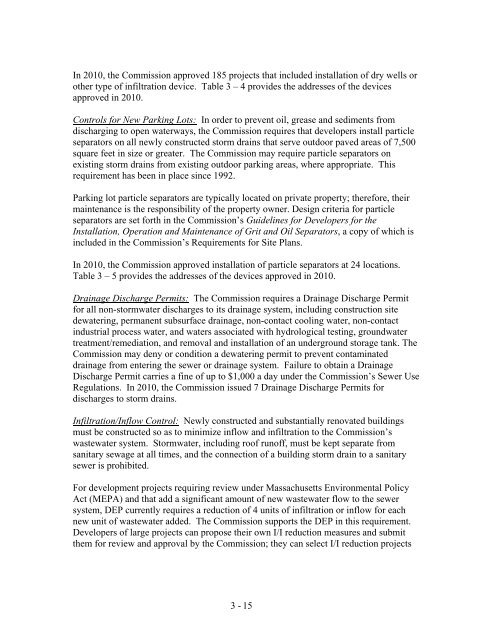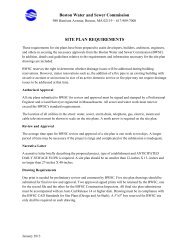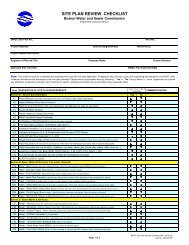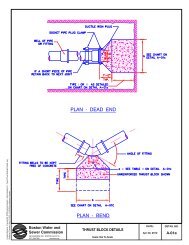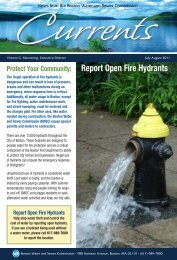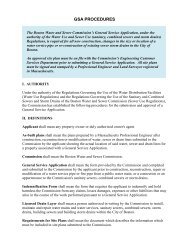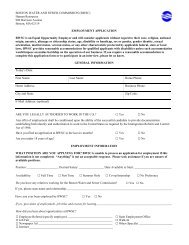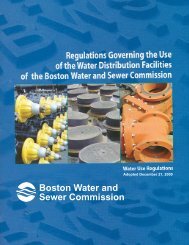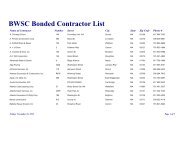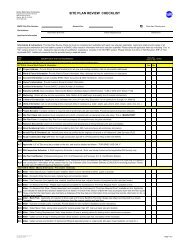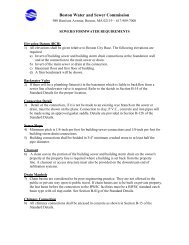2010 Stormwater Management Report (PDF) - US Environmental ...
2010 Stormwater Management Report (PDF) - US Environmental ...
2010 Stormwater Management Report (PDF) - US Environmental ...
You also want an ePaper? Increase the reach of your titles
YUMPU automatically turns print PDFs into web optimized ePapers that Google loves.
In <strong>2010</strong>, the Commission approved 185 projects that included installation of dry wells or<br />
other type of infiltration device. Table 3 – 4 provides the addresses of the devices<br />
approved in <strong>2010</strong>.<br />
Controls for New Parking Lots: In order to prevent oil, grease and sediments from<br />
discharging to open waterways, the Commission requires that developers install particle<br />
separators on all newly constructed storm drains that serve outdoor paved areas of 7,500<br />
square feet in size or greater. The Commission may require particle separators on<br />
existing storm drains from existing outdoor parking areas, where appropriate. This<br />
requirement has been in place since 1992.<br />
Parking lot particle separators are typically located on private property; therefore, their<br />
maintenance is the responsibility of the property owner. Design criteria for particle<br />
separators are set forth in the Commission’s Guidelines for Developers for the<br />
Installation, Operation and Maintenance of Grit and Oil Separators, a copy of which is<br />
included in the Commission’s Requirements for Site Plans.<br />
In <strong>2010</strong>, the Commission approved installation of particle separators at 24 locations.<br />
Table 3 – 5 provides the addresses of the devices approved in <strong>2010</strong>.<br />
Drainage Discharge Permits: The Commission requires a Drainage Discharge Permit<br />
for all non-stormwater discharges to its drainage system, including construction site<br />
dewatering, permanent subsurface drainage, non-contact cooling water, non-contact<br />
industrial process water, and waters associated with hydrological testing, groundwater<br />
treatment/remediation, and removal and installation of an underground storage tank. The<br />
Commission may deny or condition a dewatering permit to prevent contaminated<br />
drainage from entering the sewer or drainage system. Failure to obtain a Drainage<br />
Discharge Permit carries a fine of up to $1,000 a day under the Commission’s Sewer Use<br />
Regulations. In <strong>2010</strong>, the Commission issued 7 Drainage Discharge Permits for<br />
discharges to storm drains.<br />
Infiltration/Inflow Control: Newly constructed and substantially renovated buildings<br />
must be constructed so as to minimize inflow and infiltration to the Commission’s<br />
wastewater system. <strong>Stormwater</strong>, including roof runoff, must be kept separate from<br />
sanitary sewage at all times, and the connection of a building storm drain to a sanitary<br />
sewer is prohibited.<br />
For development projects requiring review under Massachusetts <strong>Environmental</strong> Policy<br />
Act (MEPA) and that add a significant amount of new wastewater flow to the sewer<br />
system, DEP currently requires a reduction of 4 units of infiltration or inflow for each<br />
new unit of wastewater added. The Commission supports the DEP in this requirement.<br />
Developers of large projects can propose their own I/I reduction measures and submit<br />
them for review and approval by the Commission; they can select I/I reduction projects<br />
3 - 15


